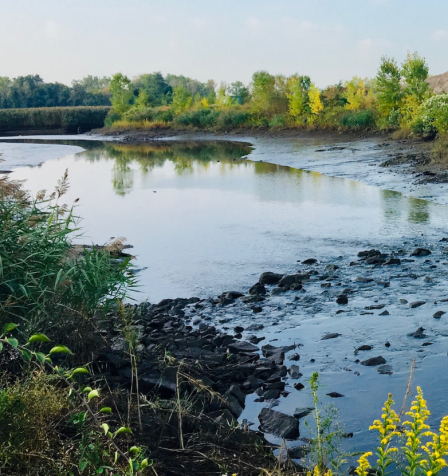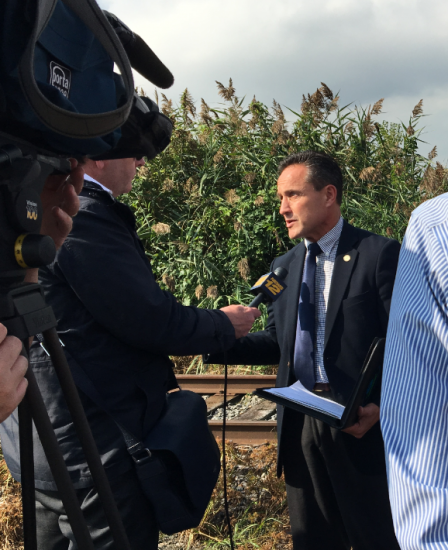News Releases from Region 02
EPA Moves Forward with $332 Million Cleanup of Berry's Creek, Bergen County, NJ
(New York, N.Y.) Today, the U.S. Environmental Protection Agency (EPA) announced the selected cleanup plan to remove mercury, PCBs, and chromium contamination from the Berry’s Creek Study Area, which is part of the Ventron/Velsicol Superfund site in Bergen County. Acting EPA Administrator Andrew Wheeler signed off on the cleanup plan on September 25. At today’s event in Moonachie, New Jersey, EPA Regional Administrator Pete Lopez was joined by New Jersey Department of Environmental Protection (NJDEP) Acting Associate Commissioner for Policy Katrina Angarone to highlight this major milestone in the Berry’s Creek recovery.
“This cleanup plan represents significant environmental progress for the people of New Jersey and the restoration of water bodies and land impacted by the contamination,” said Acting EPA Administrator Andrew Wheeler. “Under President Trump, the Superfund Program is a top EPA priority, and we are making great progress expediting sites through the entire remediation process and returning them back to safe and productive use.”
“EPA is moving forward with a smart and scientifically sound approach to clean up the contamination responsible for the greatest risks to the environment and which threaten other areas of Berry’s Creek,” said Pete Lopez, EPA Regional Administrator. “The New Jersey Meadowlands have suffered environmental degradation for decades and it is past time to take action that will put the Berry’s Creek area on the path to recovery.”
“EPA began looking at cleaning up Berry’s Creek nearly a decade ago. Today’s record of decision gets us one step closer to that goal. Remediating Superfund sites goes a long way to protecting natural resources and public health. And it is only right that the polluters, and not the taxpayers, are expected to bear the financial responsibility for cleaning up the mess they created,” said Congressman Bill Pascrell, Jr. “I also believe that advancing work at the heavily-contaminated Berry’s Creek Study Area can allow us to start addressing the broader problems throughout the Meadowlands and Hackensack River.”
“The New Jersey Department of Environmental Protection looks forward to continued work with the EPA on remediating Berry’s Creek and removing the high concentrations of chemicals from the waterway,” said Mark J. Pedersen, the DEP’s Assistant Commissioner for Site Remediation and Waste Management. “This interim cleanup should not only improve the overall environmental health of Berry’s Creek but add greatly to the quality of life and public health for residents in nearby communities.”
Berry’s Creek is a tributary to the Hackensack River traveling through Carlstadt, East Rutherford, Lyndhurst, Moonachie, Rutherford, Teterboro, and Wood-Ridge, and includes approximately six miles of waterway, tributaries to the creek, and approximately 750 acres of marshes. The major contaminants in the Berry’s Creek Study Area are mercury, methyl mercury, PCBs, and chromium, which are at high levels in the water and sediment. The areas selected for this cleanup address a major portion of the contamination within Berry’s Creek, which act as a source of contamination to the other areas of the site, as well as to animal life.
Over the course of the past seven years, EPA has overseen an in-depth investigation of the extent of the contamination, examining sediment, water and fish sampling data, as well as assessing how the tidal action in the creek moves sediment through the watershed. The cleanup announced today once completed will be studied for its effectiveness, and a final cleanup decision will be made at a future date.
Berry’s Creek Superfund site was included on the first-ever Administrator’s Emphasis List. The Administrator’s Emphasis List is composed of sites that will benefit from the Acting Administrator’s immediate and intense action. Specifically, the site was added to expedite the release of the cleanup plan – an important step in addressing serious contamination at the site.


EPA Regional Administrator Pete Lopez announces cleanup plans in Bergen County, New Jersey.
Photos courtesy of the U.S. EPA.
Background
The cleanup plan includes bank-to-bank removal of sediment down to two feet in portions of the creek with backfilling and capping equal to the depth removed. It also includes the excavation and
capping of approximately 27 acres in Upper Peach Island Creek marsh, where some of the highest surface concentrations of contaminants were found. Further, a demonstration project will be conducted on several acres of marsh to provide information on the effectiveness of the cleanup and provide information for future decisions. The cleanup plan is sensitive to ongoing flood mitigation efforts in the Meadowlands and EPA coordinates regularly with the NJ Rebuild by Design project team.
The Agency expects that the estimated $332 million proposed cleanup would be conducted and paid for by a group of potentially responsible parties for the contamination, with oversight by the EPA.
EPA held a public meeting in Little Ferry, NJ in May 2018 to explain its cleanup proposal, discuss the other cleanup options that were considered, and to solicit public comments.
To read the EPA’s selected cleanup plan, outlined in a Record of Decision, and to view EPA’s responses to public comments in the Responsiveness Summary, please visit: www.epa.gov/superfund/ventron-velsicol.
The Superfund program has been providing important health benefits to communities across the country for more than 35 years. Superfund cleanups also strengthen local economies. Data collected through 2017 shows that at 487 Superfund sites in reuse, approximately 6,600 businesses are generating $43.6 billion in sales and employ 156,000 people who earned a combined income of $11.2 billion.
On the one-year anniversary of the EPA’s Superfund Task Force Report, EPA announced significant progress in carrying out the report’s recommendations. These achievements will provide certainty to communities, state partners, and developers that the nation’s most hazardous sites will be cleaned up as quickly and safely as possible.
EPA’s new “Superfund Task Force Recommendations 2018 Update” is available at: https://www.epa.gov/superfund/superfund-task-force-recommendations-2018-update
Follow EPA Region 2 on Twitter at http://twitter.com/eparegion2 and visit our Facebook page, http://facebook.com/eparegion2.
18-077

